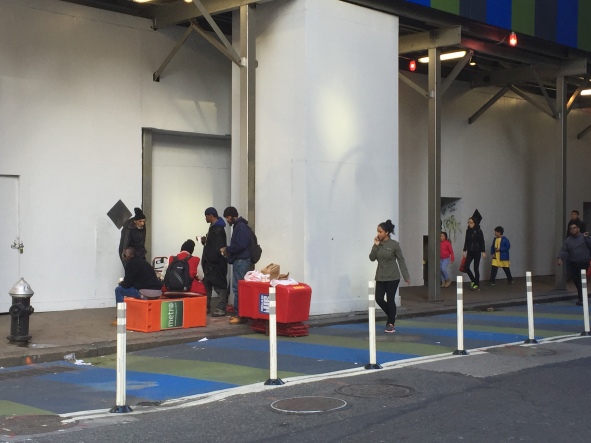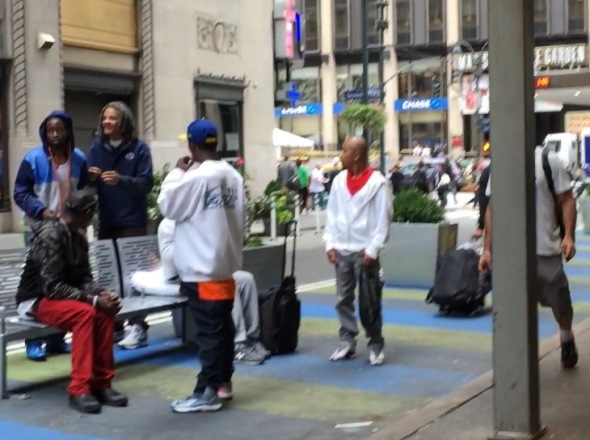

The face of 32nd Street plaza changed on the morning of Sept. 23, one day before the Pope’s visit to Madison Square Garden, when benches that had been installed in July, and had attracted a community of the homeless as well as alleged drug users, were removed.
In recent years, New York City has witnessed an increase in the levels of homelessness to the current peak of 58,000, the highest since the Great Depression of the 1930s. People who sit on street corners with cardboard signs asking for help, or take benches for beds and shopping carts for closets, have become a common sight in NYC.
This group was different. Father Paul Lostritto, of the Church of St. Francis of Assisi on West 31st Street, said that the plaza was marked by drug use, as was the block the church is on, which made some local residents and business employees uneasy. “The people on 31st Street, drug addicts are much more of K2 addicts. You get crazy behavior all day long,” he said. “On 32nd street, they’re mostly heroin addicts. You can tell cause they’re all falling asleep against each other. In fact. I know some of the people even sell.”
“The benches have created a flurry of negativity in the neighborhood,” said Lostritto, who said that local businesses complained of “too much riffraff.”
And then, overnight and a day before the Pope’s visit, the benches were gone.
—
Before the benches disappeared, rolled-up cigarettes and white clouds of smoke made the street reek with the smell of marijuana, according to a nearby shopkeeper. The unpredictable behavior of the people of the benches — who would wander the street like zombies, suddenly embark on tantrums, or pass out on the side of the street — annoyed nearby businesses, according to Abu Karr, a souvenir shopkeeper on the street.
When the benches were installed, Karr began burning incense inside his store to get rid of the smell of drugs. “You can’t arrest the homeless because they’re just there,” he said. “Some of them are nice guys, no problem. They don’t really come inside. I take pictures with some,” he said with a smile, reaching for his phone as proof. Though Karr seemed upset at the ongoing drug situation, he believes most of the plaza’s residents were “harmless.”
An employee at Little Italy Pizza – a restaurant on the same strip – disagreed. “It’s bad for business,” he said, pointing to a man lying on a pavement near the bench with his glasses knocked off his face. “Who wants to see that?”
The Vornado-owned Hotel Pennsylvania is a tourist landmark on 32nd street with rates of up to $500 a night. A hotel employee, who asked not to be named, said the benches attracted lots of negative attention and brought a “bad look to the hotel.”
One of the residents of the makeshift community is a 45-year-old man who identifies himself as a heroin addict and alcoholic. With a black net that conceals his hair, worn out baggy jeans, and a black backpack, he spent most of his days hanging around those benches.
“Everybody here has a story that’s different,” he said. “The struggle is the same, but the story is different.” He came to the area from North New Jersey a year and a half ago to start a drug rehabilitation program, which he goes to six days a week, he said.
“So what’s a goal for me isn’t really a goal for someone else,” he said. “Sometimes I live minute to minute; sometimes, hour to hour.” As he talked, a man walked over from the direction of Madison Square Garden and handed him some change. He nodded, pressed a rolled cigarette in the man’s palm, and looked around to check if anyone has noticed.
The benches on 32nd street were often occupied by people who sat slumped into themselves, their arms tucked into their shirts to protect them from the evening chill. Their belongings sat next to them, faded pillows and plastic bags. Some were sleeping. Some massaged their calloused feet. And some seemed to fade in and out of consciousness.
Many shelters, such as Common Ground, which offers services to help set up residents with long-term employment, do outreach work that includes regular visits to 32nd street. Some have used their services temporarily while others don’t want this kind of help. Common Ground, which has a strict media policy, refrained from commenting.
The city can’t force people off the streets against their will, said Miguel Acevedo, president of the Fulton House Tenants Association and an advocate for public housing. He said sometimes the homeless prefer the streets, where they feel safer in clusters.
Acevedo added that many times the issues of homelessness and mental illness feed into each other, with homelessness perpetuating a sense of helplessness and depression that exacerbates other mental health conditions.
“Those are the ones the city needs to concentrate on the most, because those are the ones that are dangerous,” Acevedo said. “Those are the ones that will really affect the community.”
On one occasion, an agitated man in a lettered jacket and Nike sneakers approached a fellow bench community member, asking the latter for a fight. The two begin yelling and only broke up when the man in the jacket sprinted away screaming. “He stabbed me, he stabbed me.” Shopkeepers came out of their stores and other homeless people began to cluster around.
After moving away from his attacker, the man who was stabbed took off his jacket, revealing a growing red stain on his back. Two onlookers asked him to put his jacket back on in order to avoid trouble with the police. Others advised him to get in a cab and go to the hospital.
But neither man wanted the police involved, and both moved away. A few minutes later, the man with the knife returned to the bench, where people had fallen silent.
—
Bud Perrone, of Rubenstein Public Relations, which represents the Department of Transportation, says that the experimental plaza is over, early: the benches will not be re-installed. Father Lostritto still interacts with the homeless on a daily basis through the church’s breadline program, which feeds 400 hungry people every morning. Hadi King, a member of the homeless community, said that the people who briefly called the benches home feel largely invisible.
“They feel nobody cares about them,” he said. “People over here are in desperate need of help, and not just with housing. It’s mental health issues. It’s sad, but that’s the situation. This is the bottom of the bottom. You can’t get lower than this.”
But they refuse to disappear. They have found their own alternative; they have flipped abandoned newspaper racks and made their own makeshift benches. The community is staying put.